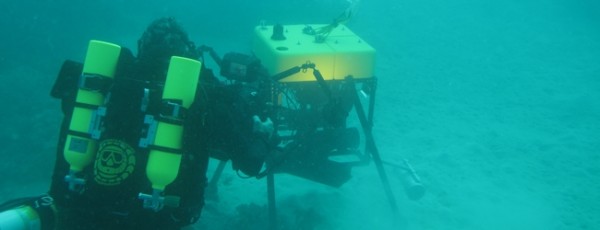State-of-the-art underwater camera films giant squid south of Japan
A new state-of-the-art underwater camera has been used to film the first-ever footage of a giant squid in its natural habitat in deep water south of Japan. Medusa is a remote-operated camera craft designed to film unobstrusively in deep-sea environments.
Giant squid are deep-water creatures so elusive that a specimen was only photographed for the first time in its natural habitat in 2004. Medusa was deployed in total darkness at a depth of 700 metres, cushioned with ‘syntactic foam’ and equipped with camera facilities developed to operate in these conditions.

The expedition was organised by NHK (Japan Boradcasting Corporation), NHK Enterprises and Discovery Channel, with the involvement of researchers from the University of Queensland. It actually took place in July 2012 but the public announcement was delayed to allow time for documentary footage to be properly prepared.
“We use far-red lighting,” explains Lee Frey, chief engineer on the project and President of Blue Turtle Engineering in Florida: “Unlike infrared, this light is still visible to the naked eye and appears deep red."
It’s not just the camera that is the important thing for filming unobtrusively in the deep sea. It's the entire system - the whole deployment scenario - that really counts.
Lee Frey, Blue Turtle Engineering
“The key here is to make sure that the light is very red and very monochromatic; that is, a distinct single colour," Frey adds: "It is this sort of red lighting that is invisible to deep-sea critters, yet still visible to the camera and [it] still has a far enough penetration distance (a few metres) through seawater to be useful.”
Medusa operates silently and independently for up to several weeks at a time using Lithium Ion batteries and also measures the conditions in the seawater around it. She is then recalled to the surface using sound waves and located via a satellite beacon and strobe light.
“It’s not just the camera that is the important thing for filming unobtrusively in the deep sea,” Frey concludes: “It's the entire system - the whole deployment scenario - that really counts.”
Related Posts
- Filming in Bolivia with the Benavides family
- Wildlife filming: What producers should know
- The Canyons – a filming survival guide
- Blue Note Productions develops 3D underwater camera for Mexican caves
- Black & Cameron uses 96-camera rig on location in China for Land Rover
- Partizan travels from Mexico to Alaska for Honda and films with a 360-degree camera
- Arts Alliance Media secures EUR43 million
- Mountaineering drama Everest films Nepal and builds peak at Pinewood
Related posts:
Comments
Not Logged in
You must be logged in to post a comment
There are no comments